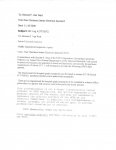- Location
- Logan, Utah
I have a sneaking suspicion that you already know this... but I assume that he/she may have a "staff opinion" from NFPA. According to NFPA's web-site there has only been one FI issued and it was for article 410 (dealing with the 2008 NEC).
Pete
A staff opinion is just that, the opinion of someone that works at NFPA and holds no more weight than anyone else's opinion.
Chris

